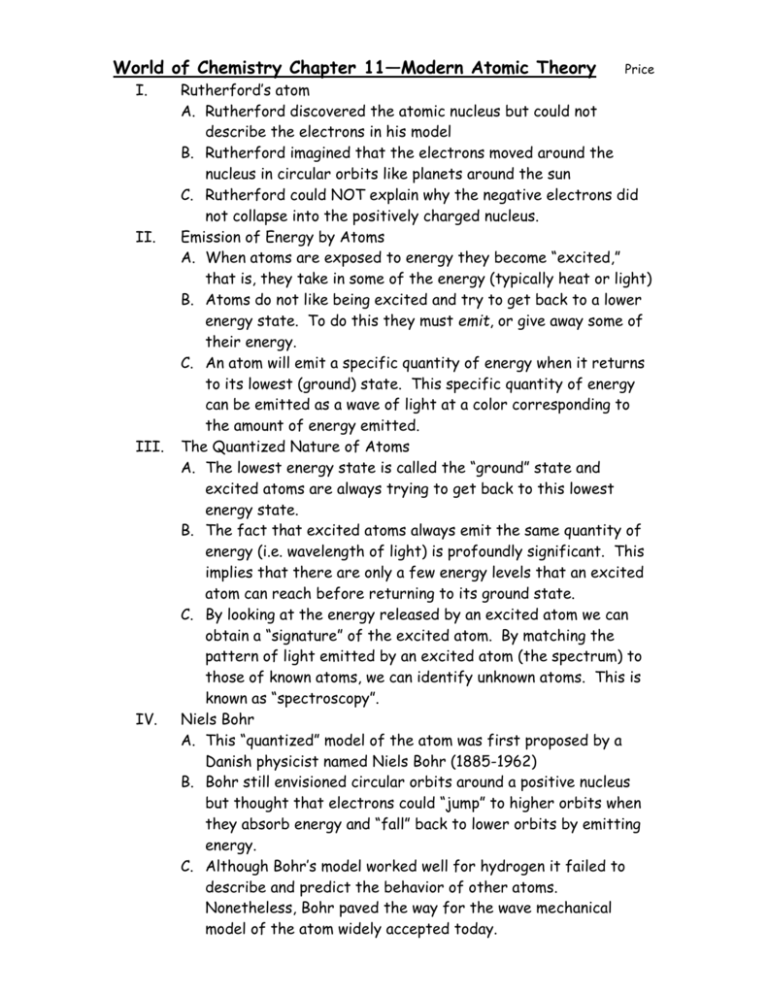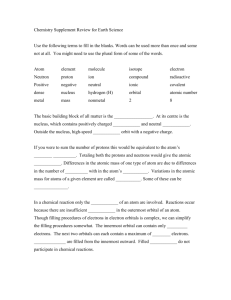World of Chemistry Chapter 11—Modern Atomic Theory
advertisement

World of Chemistry Chapter 11—Modern Atomic Theory I. II. III. IV. Price Rutherford’s atom A. Rutherford discovered the atomic nucleus but could not describe the electrons in his model B. Rutherford imagined that the electrons moved around the nucleus in circular orbits like planets around the sun C. Rutherford could NOT explain why the negative electrons did not collapse into the positively charged nucleus. Emission of Energy by Atoms A. When atoms are exposed to energy they become “excited,” that is, they take in some of the energy (typically heat or light) B. Atoms do not like being excited and try to get back to a lower energy state. To do this they must emit, or give away some of their energy. C. An atom will emit a specific quantity of energy when it returns to its lowest (ground) state. This specific quantity of energy can be emitted as a wave of light at a color corresponding to the amount of energy emitted. The Quantized Nature of Atoms A. The lowest energy state is called the “ground” state and excited atoms are always trying to get back to this lowest energy state. B. The fact that excited atoms always emit the same quantity of energy (i.e. wavelength of light) is profoundly significant. This implies that there are only a few energy levels that an excited atom can reach before returning to its ground state. C. By looking at the energy released by an excited atom we can obtain a “signature” of the excited atom. By matching the pattern of light emitted by an excited atom (the spectrum) to those of known atoms, we can identify unknown atoms. This is known as “spectroscopy”. Niels Bohr A. This “quantized” model of the atom was first proposed by a Danish physicist named Niels Bohr (1885-1962) B. Bohr still envisioned circular orbits around a positive nucleus but thought that electrons could “jump” to higher orbits when they absorb energy and “fall” back to lower orbits by emitting energy. C. Although Bohr’s model worked well for hydrogen it failed to describe and predict the behavior of other atoms. Nonetheless, Bohr paved the way for the wave mechanical model of the atom widely accepted today. V. The Wave Mechanical Model of the Atom A. In Bohr’s model the electron moved around the nucleus in circular orbits. In the wave mechanical model electrons are found to occupy certain areas around the nucleus called orbitals. Orbitals are nothing like orbits!!! B. An orbital is an area where we will probably find an electron 90% of the time. We can never know where an electron is or predict where it will be next. C. The wave mechanical model provides us with 4 types of orbitals. s orbitals are sphereical p orbitals have 2 lobes d orbitals have 4 lobes f orbitals look like this VI. VII. Spin and Exclusion A. The wave mechanical model provides us with one more characteristic of electrons: spin B. Electrons seem to spin around an axis just like a child’s toy top. 2 electrons can share an orbital only if they have opposite spins. C. Each orbital can only hold 2 electrons! D. Pauli Exclusion Principle: “An atomic orbital can hold a maximum of two electrons, and those two electrons must have opposite spins.” Modern Electron Configurations A. The wave mechanical model gives us a more sophisticated way of describing electrons in their orbitals—No More Shells! (They didn’t work that great anyway!) B. Refer to daigrams 11.31 and 11.32 on p.345 of your book for the order and pattern of orbital filling (be very careful with the lanthanides and actinides!) C. Shortcut: To save time, space and energy put the preceding noble gas in square brackets and start your electron configuration from the beginning of the period!






